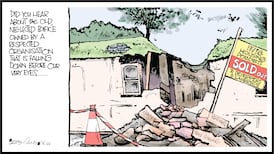Detoxification and an international reserve currency are some of the daunting challenges facing the G20 summit, writes TONY KINSELLA
HOW LONG will we have been waiting when our economies begin to turn around? That’s the multi-trillion future perfect continuous question we face.
In January, the US navy commissioned its nuclear-powered aircraft carrier USS George H Bush. A week ago the Tata corporation commercially launched its Nano, the world's cheapest car. Both are marvels of engineering. One is 333m long and cost €4.6 billion, the other is just three metres and retails for around €1,500. The carrier represents a familiar, if failing, past – the Nano our unfamiliar and challenging future.
Contributing editor of Car Magazine Ben Oliver described the Nano as “a staggeringly important, clever, exciting new thing”. In the face of threatened global economic meltdown, with the ILO predicting 51 million job losses in 2009, it at least offers hope.
The conservative economic guru Hernando de Soto Polar straddles our global rich-poor divide having spent nearly half his life in Switzerland before returning to his native Peru. He estimates there is something of the order of €10 trillion worth of cash in circulation on our planet. This is amplified by around €125 trillion of classic debt. Two highly regulated, and clearly recorded categories, neither of which poses significant problems. There is, however, a third element of wealth in circulation, and one that threatens our economic survival – derivatives and other loans.
De Soto Polar estimates these as having a paper value of between €450 trillion and €750 trillion. In the words of another leading economist, Paul Krugman of Princeton University, they resulted from a process where “Loans no longer stayed with the lender. Instead, they were sold on to others, who sliced, diced and puréed individual debts to synthesise new assets. Subprime mortgages, credit card debts, car loans – all went into the financial system’s juicer.”
Many, perhaps most, of these are, at the very least, not worth their face value. Some are simply worthless. Lots exist as bearer bonds which have no registered owner – the bearer being held to be the owner. De Soto Polar points out this makes them uncannily resemble untitled properties in the shanty towns around cities in the developing world – difficult to value and useless as collateral.
Banks holding such paper are stuck with toxic assets. In Ireland, a significant amount consists of loans secured against properties valued during our days of collective madness when square metres in Dublin were adjudged to be worth more than their Paris equivalents. While those valuations are no longer valid, the properties retain some value. Their more toxic relations are simply worth nothing. Valuing some and writing off the worthless is a process known as detoxification.
The planet has saved its banking system through the provision of liquidity – a vital, though painful, first step. The second was to restore, bypass, or complement normal liquidity lending to companies to ensure their temporary survival.
The dramatic drop in vehicle purchases left manufacturers with enormous stocks and acute cashflow problems – US sales are predicted to fall to 9 million in 2009 from 16 million last year. In the US support has taken the form of direct government loans to car companies. In Germany one main tool has been kurzarbeit, where businesses cut working hours but the state compensates around two-thirds of lost earnings.
The third step will be the detoxification challenge, and here German experience may help. Some 300 experts worked through the assets of the former GDR after reunification, valuing and disposing of properties and funds from the old East Germany. That expertise is now required at a global level, most particularly in the US and the UK. The emerging economies, China, Brazil, India and others, are willing to participate in a global rescue, but not in refloating a failed system where they are under-represented. The three Benelux countries have more voting rights in the IMF than Brazil and China combined.
President Lula da Silva of Brazil points out: “This crisis was fostered and boosted by irrational behaviour of some people that are white, blue-eyed . . . they looked like they knew everything about economics, and . . . have demonstrated they know nothing.”
At some stage in our global detoxification efforts, a swathe of toxic paper wealth will have to be written off. Some individuals and institutions are going to have to take massive, and largely uncompensated, hits.
Here another, more dramatic, German experience may also offer guidelines. The deutschmark was introduced on Sunday June 20th, 1948, wiping out many holdings of questionable value and origin while laying the basis for Germany’s economic miracle.
The governor of China’s central bank, Zhou Xiaochuan, has called for the creation of “an international reserve currency . . . anchored to a stable benchmark and issued according to a clear set of rules . . . disconnected from economic conditions and sovereign interests of any single country” to replace the US dollar. US treasury secretary Tim Geithner was initially “quite open” to considering such a move.
Stimulus packages, global detoxification, clear regulation and supervision to prevent a repetition of the madness that got us into this mess, coupled with debate on an international reserve currency that reflects planetary economic realities to replace the dollar, these are the daunting challenges facing the G20.
If it begins to seriously address them, we will at least still be facing a future perfect continuous question.









